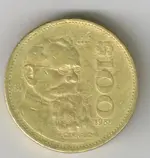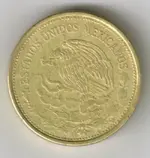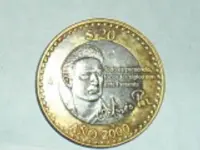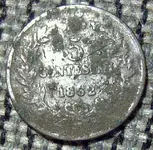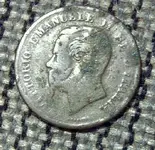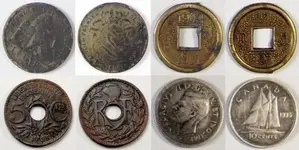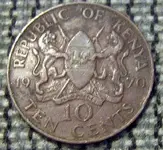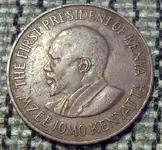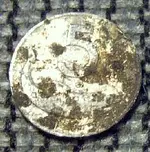I don't keep a count of the more modern foreign coins I've found (i.e., those dated after 1950, unless they're silver. The more modern world coins go into my Wheatie and token jar instead of my main "Digger's Diary" album.
Here are the world coins that are in my album, in the order they were found.
#1, (Coin #1 in my album):
1944 Mexico 5 Centavos. The very first coin I found with my detector- even before I found a Memorial cent! It was in our front yard- our house had been occupied by Mexican laborers during WW2, I later found out.
#2: (Coin #12 in my album):
1913 Canadian large cent. A bit of a heartbreaker, as it was in very nice condition before I scratched it with my digging knife. I wasn't digging too carefully because I expected it to be a screwcap (rang in just below zinc penny range on my detector's meter.)
#3 (Coin #24 in my album):
1966 Canadian 10 cent piece. First foreign silver for me- though the US had quit making silver dimes by 1966, Canada continued making (80%) silver coins for circulation until 1968.
#4 (Coin #80 in my album):
1914 Canadian large cent. When found, this was mounted in the center of an aluminum disc, obviously one of those encased "lucky coin" things, but the aluminum part was so horribly corroded it was unreadable and had to be discarded. The cent itself had some crud on it but nice details.
#5 (Coin #115 in my album):
No Date (ca. 1876-1901) Canadian large cent. A Queen Victoria Canadian large cent with decent detail, but the date was so weakly struck that it was the first thing to wear off the reverse.
#6 (Coin #157 in my album):
1943-D Australia sixpence, made into a button. This coin was tapped into a convex shape and made into a button, probably during WW2. A US serviceman probably brought it home as a war souvenir. Interestingly, it was originally struck at Denver in the USA- the US Mint struck many coins for foreign governments during the war.
#7 (Coin #161 in my album):
1776-FM Spanish Colonial (Mexico City) half-real. Holed. This was my first coin from the 1700's. I found another half real on the same site, a few feet away, the next morning. I have used pics of this coin as my avatar on some internet chatboards. Though the avatar pictures below are "staged" and the dirt in the pictures covers the hole in the coin, it did sort of look like that when I dug it.
#8 (Coin #162 in my album):
1787-FM Spanish Colonial (Mexico City) half-real. Found on the same site as the previous coin. This Spanish silver circulated widely in the USA before 1857, and there probably more Spanish silver than US silver in circulation here in the South, at least until well after the Civil War.
#9 (Coin #187 in my album):
1779-FF Spanish Colonial (Mexico City) 2 reales. First of what I call "The Colonial Trio", which were all found on one site.
#10 (Coin #188 in my album):
1782 Irish "Hibernia" halfpenny (contemporary counterfeit). Second of "The Colonial Trio".
#11 (Coin #189 in my album):
1782-A French Guiana (Colony of Cayenne) 2 sous. Third of "The Colonial Trio".
#12 (Coin #201 in my album):
1781-FF Spanish Colonial (Mexico City) half-real. Holed. Found in a sand road that dated to colonial times. A Civil War button was found nearby, so it might have been dropped after the colonial period.
#13 (Coin #203 in my album):
No Date (ca. 1780-1793) France 6 Deniers or 2 Sols. Found in the same colonial sand road as the previous coin. Very nearly unidentifiable, except for a very faint outline of King Louis' head.
#14 (Coin #216 in my album):
1940 Canada one cent. Not a terribly exciting find, but since it predated 1950 I put it in the album instead of my bulk "Wheatie & Token" jar.
#15 (Coin #224 in my album):
1658 Spain 2 maravedis. I call this one "THE coin", for many reasons. First, it is the oldest coin I have found so far. Secondly, it made the papers across the state (and later the country, via wire services) for its historical significance, since it turned out to be a clue to the location of a long-lost Spanish mission. Third, when I took it to work and showed it off with the newspaper clipping, I was able to strike up a conversation with a nice lady, who's now been my wife for six years.

Newspaper clipping:
http://images.honesty.com/imagedata/1/0/9/14595109.jpg
#16 (Coin #245 in my album):
1941 Great Britain shilling (Scottish reverse). Silver.
#17 (Coin #260 in my album):
1738 Great Britain halfpenny.
#18 (Coin #262 in my album):
No Date (circa 1770's-1780's) Spanish Colonial (Mexico City) 1 real. Made into a crude love token of sorts- holed and crudely engraved with the initials "SD". Found near Charleston, SC, on a site that produced artifacts dating from the Revolutionary War to the early 1800's. Worn nearly smooth, but the mintmark and part of the shield were visible.
That's it for now. I have dug a number of other world coins but they were more modern and I didn't log them into the Digger's Diary.



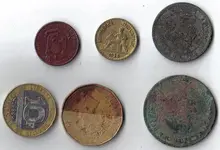





 . I also found what I thought was my first gold coin way up in the hills near here, washed up on the bedrock of a creek. Just about came unglued when my detector screamed at me, and I saw that "gold" edge sticking out of the dirt! Man, I was staggered- I found out later it's not gold, however, but still an interesting piece found in the most unusual of places.
. I also found what I thought was my first gold coin way up in the hills near here, washed up on the bedrock of a creek. Just about came unglued when my detector screamed at me, and I saw that "gold" edge sticking out of the dirt! Man, I was staggered- I found out later it's not gold, however, but still an interesting piece found in the most unusual of places.